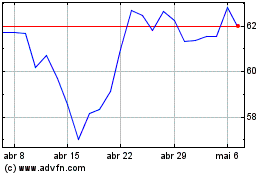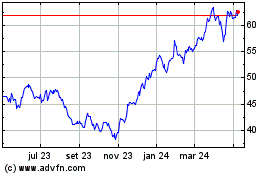Why DocuSign Stock Just Fell By 42% on Friday?
06 Dezembro 2021 - 7:07AM
Finscreener.org
Shares of
DocuSign (NASDAQ: DOCU)
fell by 42% on Friday to $135.09 per share, valuing the company at
a market cap of $26.6 billion. DOCU stock is now trading 56% below
its all-time highs.
What impacted DocuSign last week?
In the fiscal third quarter of
2022 that ended in October, DocuSign
reported revenue
of $545.5 million, an increase of
42% year over year. Its subscription sales rose 44% to $528.6
million while adjusted earnings more than doubled to $0.58 per
share. Comparatively, Wall Street forecast Q3 sales of $530.67
million and earnings of $0.46 per share. So why did DOCU stock
crash despite beating consensus estimates for Q3?
Investors and analysts were
worried about the company’s decelerating growth after economies all
over the world are reopening resulting in slower than expected
demand for DocuSign’s suite of solutions.
DocuSign’s billings at the end of
Q3 rose 28% to $565.2 million, which was significantly lower than
the 47% growth experienced in Q2. The billings are basically the
amount of sales that have been booked but not recognized as
revenue.
In fiscal Q4 of 2022, DocuSign
forecast sales between $557 million and $563 million, below
estimates of $574 million. DocuSign estimated billings of $653
million in fiscal Q4 which again fell short of Wall Street
forecasts of $705.4 million.
DocuSign’s CEO Dan Springer said
the weak demand was disappointing after a pandemic-fueled year
allowed the company to record exceptionally high growth rates at
scale. In fact, DocuSign experienced six quarters of accelerated
growth after which customers returned to normalized buying
patterns.
Wall Street downgrades DOCU stock
Shortly after DocuSign’s less
than impressive Q3 results, several analysts on Wall Street
downgraded the stock.
According to multiple reports
from TheFly:
- JPMorgan (NYSE:
JPM) downgraded DocuSign
stock to “underweight” from “neutral” with a price target of
$175
- UBS downgraded DocuSign stock to
“neutral” from “buy” and lowered its price target to $170 from
$350
- Piper Sandler downgraded
DocuSign stock to “neutral” from “overweight” and lowered its price
target to $200 from $330
- Citi (NYSE: C)
maintained a buy rating on DocuSign stock but lowered its price
target to $231 from $389
Several other investment banks
including Wells Fargo (NYSE:
WFC), Wedbush, and RBC
Capital (NYSE:
RY) also lowered 12-month
price targets for DocuSign stock.
Let’s see if the ongoing pullback
provides long-term investors an opportunity to buy the dip or will
it continue to move lower in the upcoming trading
sessions.
The bull case for DocuSign
DocuSign has estimated its total
addressable market at $50 billion providing it with enough
opportunities to grow top-line at a rapid rate. It is well poised
to keep gaining traction in a world that’s increasingly shifting
towards a digitally-powered economy. DocuSign has already increased
sales from $518 million in fiscal 2018 to $1.45 billion in fiscal
2021. In the last 12-month period, its sales have stood at $1.79
billion.
DocuSign will now have to
transition from demand fulfillment to demand generation which means
revenue is all set to decelerate in the next few quarters. In case,
the company reports sales of $2.09 billion in fiscal 2022, its
three-year growth rate stands at 42%. Further, its earnings are
also forecast to expand at an annual rate of 166% from $0.09 in
fiscal 2019 to $1.70 in fiscal 2022.
DocuSign stock is now valued at a
forward price to sales multiple of over 12x which is still steep.
It remains vulnerable in a broader market sell-off but is also one
of the market leaders in its vertical.
DocuSign stands to benefit from
multiple secular tailwinds going forward and the stock should
remain on your buying radar in the future.
Citigroup (NYSE:C)
Gráfico Histórico do Ativo
De Mar 2024 até Abr 2024

Citigroup (NYSE:C)
Gráfico Histórico do Ativo
De Abr 2023 até Abr 2024
